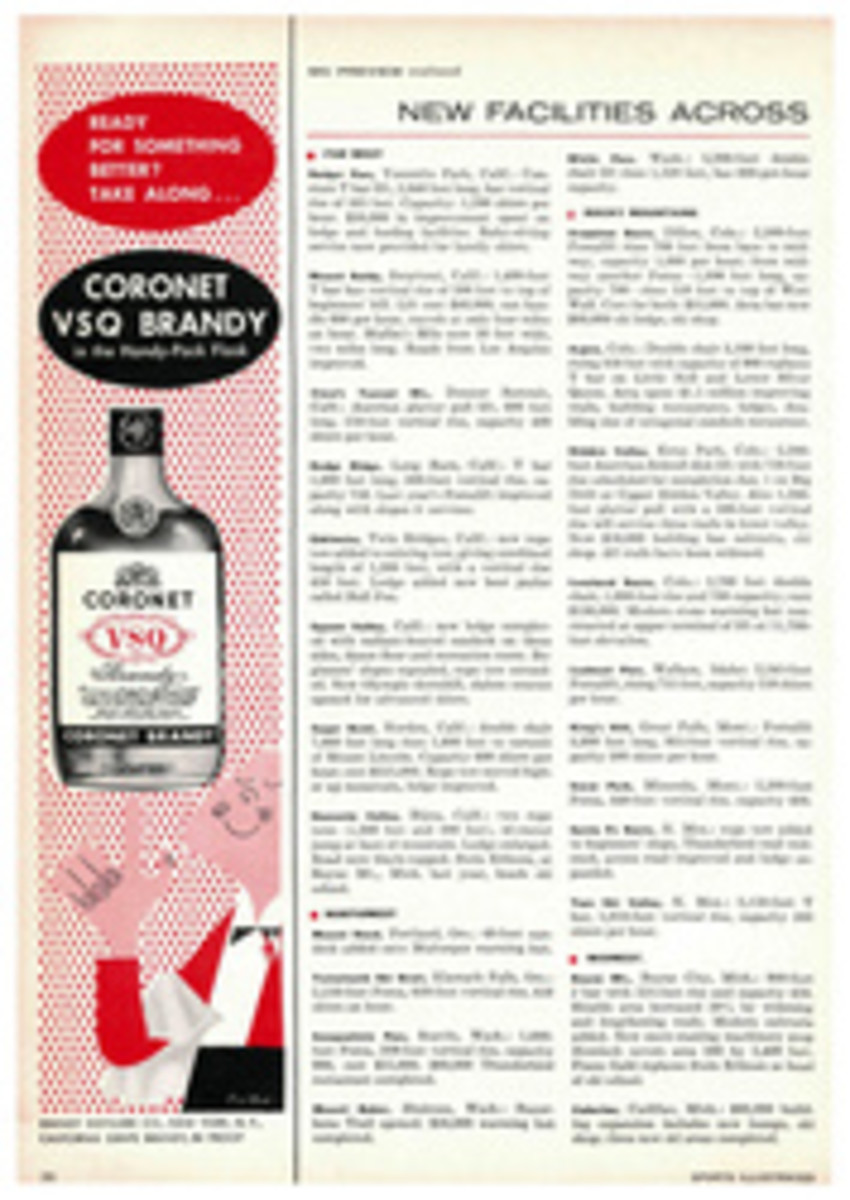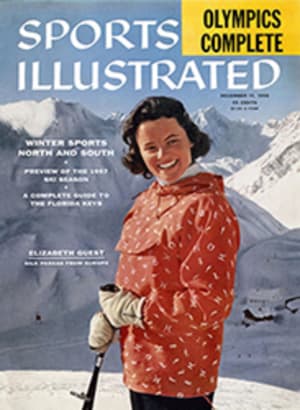
SUNNY SKI STYLES
Lying on the sun-drenched beaches of the Cote D'Azur a bather, if he is so inclined, can lift his eyes and see the snowy peaks of the Alps hovering like clouds in the distance. With the distance between summer and snow thus foreshortened, it is not so strange that the newest ski fashion in Europe comes from the sunny Mediterranean playland where the distinctive printed shirts of Sportsman-Designer Emilio Pucci are highly popular with the international resort set.
Pucci's bright prints in, of all things, silk, now dot the ski slopes. Following closely the fashion for bright colors and the trim-fitting elastic ski pants that jumped the Atlantic from the Alps to American slopes last year, the shirts are practically bulkless, can be tucked into elastic pants without a bulge. They can even be folded into a pocket when not needed. Drawstring-hipline parkas are also popular in such typical Emilio prints as mermaids (see cover) and imitation mink. Most skiers wear them over cashmere sweaters and find them warm enough for the sunny upper slopes of Sestriere, Klosters and Zermatt, where the pictures on the following pages were taken.
American skiers have brought these parkas back with them, and American stores now have them.
To ascertain what is being worn on the ski slopes of America this year, SPORTS ILLUSTRATED conducted a survey of its own in every important ski area in the country. The reports establish one fact as country-wide: the 3.5 million U.S. skiers consider comfort and practicality first, fashion second. As their enthusiasm for skiing grows, American skiers are developing complete wardrobes to meet different weather conditions, drawn from the best that Europe and the manufacturers of this country have to offer. Their money goes for active ski clothing, instead of after-ski or snow-bunny fripperies. Price is no object to them so long as the equipment is the best quality. The overwhelming popularity of the elasticized ski pants, which cost anywhere from $45 to $55—twice the price of a good pair of garbardine downhill pants—attests to this fact. So does the popularity of imported ski boots, also at premium prices. And so it is that imported elastic pants, skis, boots and accessories account for most of the heavy import business done by ski shops in America—an average of 60% or more of their merchandise.
In spite of this heavy European influence in ski apparel, Americans are developing their own ski look. Bulky wool-knit, waterproof sweaters, worn as parkas, are growing in popularity, and the most distinctive of them are the Cowchee sweaters, hand-knit by the Cowichan Indian women of British Columbia. They are among the most sought-after sweaters in the U.S. and in Canada in spite of their price ($75). Girls who wear them look like inverted pyramids—heavy sweaters over tight pants. They are knit in one-of-a-kind patterns, from the natural beige and black-brown of unwashed, water-repellent wool. The U.S.'s own Ivy League look has made its impression on slopes as far west as Boise, where college skiers wear tapered pants with back buckles and Ivy League caps with fold-away ear flaps. In Taos, skiers not only ride the chair lift protected by Navajo Indian serapes, but for after-ski, women don squaw skirts, velvet versions of the buckskin shirt, and squaw boots with silver Indian conches.
Since skiing in America is more a weekend activity than a long winter-resort vacation, there is little emphasis on dressing up for social life after a hard day on the slopes, except at such resorts as Mont Tremblant and Sun Valley. Most skiers wear fleece-lined, rubber-soled after-ski boots. In New England, men wear leather-trimmed corduroy pants for end-of-day gatherings. In Canada, both men and women wear miniature tartan shirts, the men wear flannel slacks, the women velveteen. In California girls wear casual corduroy slacks from Brigance of New York or velveteen tapered pants by Emilio of Italy with bright-printed silk shirts in front of the big lodge fireplace, and in New England they wear full tweed skirts with floral embroidered knee socks.
While the toggle-fastened loden duffle coat is a runaway favorite for the drive to the slopes and for the ski tow, capes are putting in an appearance this season. Monks' cloaks of navy blue gabardine lined with Milium are favorites with men in Canada; some women wear them lined with mink. And Sig Buchmayr's ski shop in New York reports a demand for imported loden ponchos called Wetterflecks (SI, Oct. 1).
Although ski knickers have failed to receive as wide acceptance as elasticized pants, Andy Mead Lawrence has popularized them in Colorado. They are being worn with watertight, hand-knit Norwegian socks, for spring skiing when the snow isn't so heavy; and by downhill racers who like them because they eliminate flapping.
New this year are elasticized ski pants which slip over the boot, instead of inside, give an elongated leg line and eliminate chafed heels. Sporthaus, a Westwood, Calif. ski shop, stocks the popular Bogner stretch pants in 13 colors and also stripes and patterns for women and eight colors for men.
Color is just as important in poplin parkas as it is in sweater detailing. Knitted hoods inset in V-shaped necklines, and knitted inserts at shoulder and side seams give smooth, taut but elastic fit. Patterns such as stripes and polka dots and pastel colors are favorite of women skiers as a switch from black or navy nylon parkas. Both European makers (Bogner, Holger Havn of Copenhagen) and U.S. manufacturers (White Stag) supply them.
Fur is also flying about the slopes, according to scattered reports. Eskimo-type fur parkas have been introduced to the U.S. by Andre of New York. Others have circles of raccoon or wolverine framing the hoods of poplin parkas. In New England that old stadium favorite, the raccoon coat, is still a treasured after-ski wrap.
For foresighted economy, ski mothers in the West and in Quebec carefully examine the expensive, European hand-knit sweaters that visiting skiers wear. They particularly note the price, then go home and get out the knitting needles. Soon the whole family is wearing identical sweaters and the kids are easier to spot on a crowded slope.
A lot of the fun of skiing has also gone to the skier's head. William J.'s jersey hoods with animal faces on the back (a pussycat, a monocled owl, a pink elephant) are seen all over, and the hot-rod downhill set is wearing padded Seelos crash helmets. As Correspondent Bob Littlejohn from Stowe advises: "Keep your eye on the girl with the polka-dot Seelos cap."
PHOTO
TONI FRISSELL
THE SILK SKI SHIRT IN EUROPE: In the Alpine ski resorts—Sestriere, Zermatt, Klosters—winter visitors ski in silk shirts and parkas designed by Italy's prolific originator of colorful sportswear, Emilio Pucci. Photographed in Europe in February (right, Mrs. Donald Gaum at Zermatt), they are now available in America at Lord & Taylor, New York; Roos Bros., San Francisco; and, for the lavender mink-printed parka shown on the following page, Julius Garfinckel, Washington, D.C.
PHOTO
TONI FRISSELL
CARRIAGE WHEEL PRINT: Silk shirt is worn over a white turtle-neck sweater and tucked into narrow waistband of beige ski pants by Mrs. Donald Gaum at Zermatt. Silk is a good windbreaker and the right weight for sunny days.
PHOTO
TONI FRISSELL
BLUE MOSAIC PRINT: Silk parka (Emilio) is cut in classic style with flapped front pocket and a drawstring hood. Nancy Gerry wears it here with slate-blue ski pants. In the background is the Matterhorn, as seen from Zermatt.
PHOTO
TONI FRISSELL
LILAC MINK PRINT: Silk parka worn by Mrs. Walter Haensli at Sestriere is the starting point for a monochromatic color scheme, completed with violet ski pants. Pastels and monochromes were much favored by European skiers.

